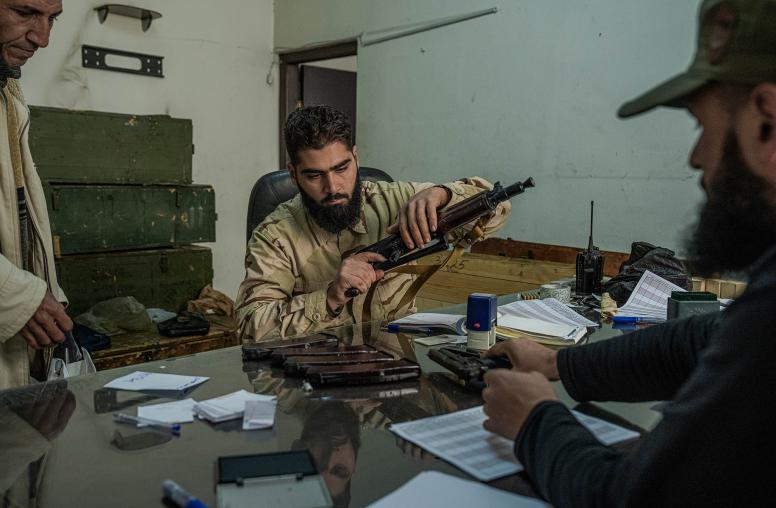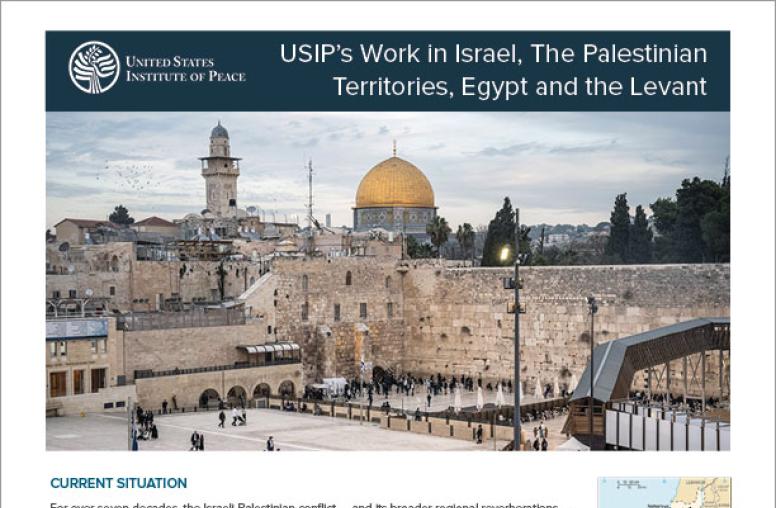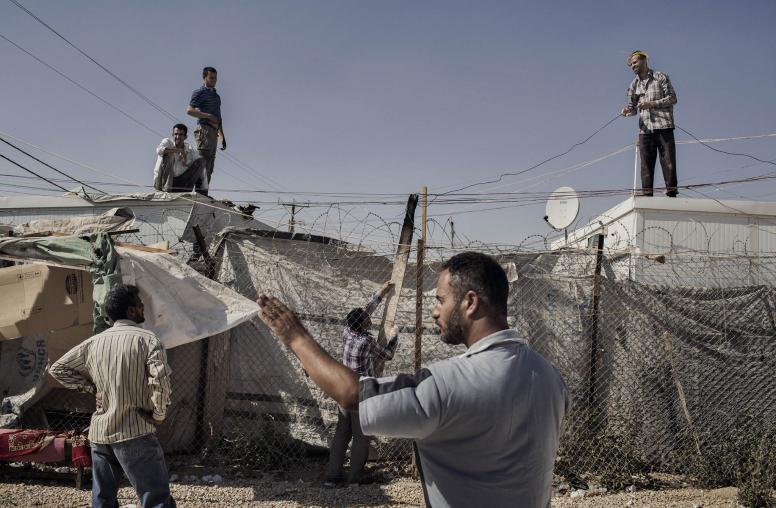The U.S. Role and Strategy in the Middle East: The Humanitarian Crisis
Testimony before the U.S. Senate Committee on Foreign Relations
USIP President, Nancy Lindborg, testifies before the U.S. Senate Committee on Foreign Relations.
More from President Lindborg following her testimony, "Refugees and Social Cohesion."

Good morning and thank you Chairman Corker, Ranking Member Cardin, and other members of the committee, for this opportunity to discuss the U.S. role and strategy in the Middle East in the midst of an escalating humanitarian crisis. Your attention to this complex and protracted crisis is important and very much appreciated.
I testify before you today as the President of the United States Institute of Peace, although the views expressed here are my own. USIP was established by Congress 30 years ago with the mandate to prevent, mitigate and resolve violent global conflict, and we do so by focusing on practical solutions, research, and training in conflict zones around the world.
I have spent most of my career working on issues of democracy, civil society, conflict, and humanitarian response. These experiences have led me to the strong conviction that we as a nation must invest more in approaches and tools that help us interrupt the spin cycles of conflict that engulf so many countries; it is more urgent than ever to get ahead of crises before humanitarian needs escalate, before conflict becomes violent and, as we are seeing now, before violence forces millions of people from their homes.
The roots of the current refugee crisis in Europe are in Syria and Iraq, as well as in Afghanistan, Eritrea, Somalia, Yemen -- all places where violent conflict, oppression, and poverty combine to create a web of hopelessness. The journey from there to Europe is long, arduous, and shockingly dangerous. And yet, according to the European Union’s border control agency, Frontex, more than 500,000 desperate people have made that journey this year, illuminating the distressing calculus that drives men, women and children to risk their lives.
The debate here and in Europe over how many refugees and migrants to accept hopefully will result in the greatest possible number of people restarting their lives in safety. We can certainly afford to absorb many more refugees here in the U.S. than is currently contemplated. More than 20 former senior U.S. government officials from both parties recently issued a public statement calling upon the U.S. to accept 100,000 Syrian refugees. However, even if Europe and the United States collectively take the most generous number of people possible, it will only scratch the surface of the crisis now stretching across a swath of fragile and conflict-torn Middle Eastern and African countries.
As the world focuses on the wave of refugees and migrants arriving in Europe, we must redouble our efforts in the frontline states. We must ensure critical assistance is reaching refugees and displaced people in the region, with an emphasis on building resilience for populations that may not go home anytime soon and helping those who can return. That also must include continued support for the countries and communities bearing the brunt of this crisis. Most importantly, we must not lose our focus on the roots of this crisis--the conflicts and oppression born of governments that are ineffective or illegitimate or both.
I recently returned from Iraq, where I met with Iraqis who have been displaced since ISIS rampaged through their villages and cities more than a year ago. They are now living in camps, containers or crowded apartments paid for with dwindling savings. Many of them are from minority communities -- Christian, Yezidi, Shabak and others -- and are terrified of returning home in the absence of security guarantees. I met with two Yezidi sisters who escaped from their captors after having been sold to three different men. Now, sharing a container with another family and without access to trauma counseling or a way to support themselves, they are sliding into a new kind of hopelessness. I also met with a young Sunni mother who is alone with her two children, determined not to return to her ravaged community but rather make it to Europe, where she believes a better life awaits. There are countless stories of people with lives interrupted by terror and, now, uncertainty.
In Iraqi Kurdistan, the strain of hosting so many displaced in clear. Churches, civil society organizations, and mosques have mobilized to provide life-saving assistance, but as the numbers of displaced continue to rise, resources are being rapidly depleted. Iraq's Kurdish region already had taken in 275,000 Syrian refugees before the ISIS expansion into northern Iraq drove another 1.5 million Iraqis towards the safety of the Kurdish region. Now, one in five residents of Iraqi Kurdistan is displaced, placing an incredible strain on a region already reeling from plunging oil prices and the constant threat of ISIS. Many people are unable to find work or ensure their children attend school. As one civil society leader noted to me, "We have seven internally displaced camps here, which equals seven time bombs, as people sit without work or education for year after year."
Nationwide, Iraq has more than 3.2 million internally displaced people crowding into cities, camps and makeshift shelter. Infrastructure--water systems, electrical supply, schools and health clinics--is all strained to serve far more people than intended. And now, reports are emerging of cholera in Iraqi cities. Just over a week ago, the World Health Organization reported that it was supporting Iraq’s Ministry of Health, which on Sept. 15 had declared a cholera outbreak in the provinces of Najaf, Diwaniya, and parts of west Baghdad. The agencies are working together to step up measures to stop transmission and prevent further spread of the disease.
The story of displacement is even more stark in neighboring countries. The population of Lebanon, with its politically fragile demographic balance, is now fully one-fourth Syrian. Lebanon, Jordan, and Turkey have been taking in refugees for five years now and together shelter 3.6 million Syrian refugees, according to the U.N.
Much of the focus is now on Syrian refugees, but there are an additional 7.6 million Syrians displaced within what is left of their country, with an astounding 12.2 million citizens inside Syria who need urgent humanitarian assistance. So as the conflict continues, the number of people choosing to leave the country is only likely to grow.
Even as we seek solutions for refugees in Europe and the U.S., we must also refocus on determined action in four areas:
- Meeting the immediate humanitarian needs in the region to ease the suffering of millions forced from their homes and living on the edge of existence;
- Recasting assistance to refugees, internally displaced and hosting communities, to emphasize longer-term resilience and rebuilding of social cohesion for what are likely to be extended displacements stemming from protracted conflicts;
- Enabling a return home for those able and willing to do so;
- Redoubling efforts to address the root causes of violent conflicts that are driving these cascades of crisis.
The Most Immediate Needs
The Syrian war, now in its fifth year, is contributing to a global humanitarian emergency of record displacement. According to the U.N., nearly 60 million people are displaced globally due to violence, conflict, and repression-- roughly equivalent to the entire population of Italy. Thanks to your important support, Senators, the United States has been the global leader in dedicating significant resources to the humanitarian response. Since the beginning of the Syrian crisis, the U.S. has committed $4.5 billion, saving countless lives. But the sustained level of crises worldwide is draining funding and attention. The U.N. has only raised 38 percent of the $7.4 billion it says is needs this year to care for Syrians fleeing the fighting, and only half of the $704 million requested for Iraqis displaced by ISIS. The World Food Programme has been forced to drop fully one-third of Syrian refugees in the region from its food voucher program this year due to funding shortfalls. The needs in Yemen, Sudan, South Sudan, and the Central Africa Republic keep falling even further from public view.
Now is not the time to shortchange critical aid programs. Even as the U.S. government continues its generous support, it is important for a broader community of nations to join in the financing of these vital life-saving programs. Despite significant efforts over the last five years to broaden the donor pool, the primary funding continues to come from a small group of nations.
There is also an urgent need to augment civilian protection for those still living inside Syria and facing daily deprivations and death. Despite a hard-fought effort that resulted in the unanimous passage of U.N. Security Council Resolution 2139 in February 2014, to ease the delivery of aid to Syrians, there has not been a serious effort at implementation. This resolution calls for unhindered delivery of humanitarian assistance across borders to those trapped inside Syria and, most importantly, a cessation of the targeting and killing of civilians, especially medical personnel. However, this resolution has never been fully respected, while the barrel bombing campaigns, targeting of civilians, and blockage of life-saving assistance continues.
Recasting Assistance for Longer-Term Recovery and Resilience
We also must ensure these assistance programs are as effective and efficient as possible. It is critical to focus on enabling refugees and displaced families to access employment, education, and trauma counseling, with the goal of helping them prepare for a future, not just survive the present.
In the face of protracted conflicts, the global average for displacement is now 17 years—it takes 17 years for families to return home, which is a lifetime for a young man or woman. And yet, all too often, aid programs, constrained by mandates, types of funding, and institutional strictures, continue to be administered as if displacement is a short-term problem.
For those displaced by violent conflict, living in strange cities, and without resources, it is a daily struggle both for survival and dignity. Host-country policies often prohibit refugees from working legally, forcing many into underground economies and unsafe work. And despite generous efforts by Jordan and Lebanon, there simply isn't enough space in their schools for the enormous number of Syrian children. Across the Middle East, some 13 million children are not attending school because they are affected by conflict. And nearly 4 million of the displaced Syrians are children, many out of school for almost five years now. Investing in the future of these children must be a top priority.
Also vulnerable are the many poor communities hosting the bulk of the refugees, especially in fragile Lebanon and Jordan. Our assistance must focus as well on building bridges between host and refugee communities and shoring up weak infrastructure and faltering economies that must now meet expanded demands. Again, thanks to your support, Senators, the U.S. government has generously provided budget support and development assistance to the region, particularly to Jordan.
Over the last five years of the Syrian conflict, the U.N., the World Bank, host country governments, and local and international non-governmental organizations have made significant strides in seeking new ways of working together to address the crisis more effectively. With U.S. support, the World Food Programme and non-governmental partners have been able to launch an e-card platform to provide cash on debit cards for food and essential non-food items, enabling women to have a choice and voice in their purchases instead of queueing up for bags of food, while also injecting critical funding into the local economy. In Jordan, U.N. agencies have teamed up to use biometric registration so refugees can use iris scans at ATM machines to access assistance, which reduces costs and increases accountability. The World Bank and the U.N. Development Program are supporting local governments to develop "resilience strategies" that chart a development course in light of the ongoing crisis.
However, there is still much more that needs to be done, especially to increase education and employment opportunities. We must seize the opportunity of this crisis to push our assistance strategies to be more creative, look longer term, and support the resilience and dignity of those we seek to help.
Enabling Returns of Refugees After Conflict
Where there is hope for displaced people to return to their home communities in the foreseeable future, the international community can begin preparing the ground now. In Iraq, military forces will drive ISIS out of occupied areas eventually, but tensions and trauma will linger. The war has militarized large segments of the society, making caches of weapons ubiquitous and violence acceptable. We can help reduce the risk that cycles of conflict will continue by investing in rebuilding communities to make the way for sustainable returns. Key to this is support for those working to rebuild the social fabric and seeking reconciliation at all levels, from the local to the federal.
In Iraq, thousands of families have already returned to Tikrit, a city in northern Iraq that was wrested from the control of ISIS in April by a combination of U.S.-led coalition air strikes and Iraqi regular and militia ground forces. Human rights organizations since then have documented accounts of retribution in the early days after that liberation because of outrage over a June 2014 massacre by ISIS of 1,700 Iraqi cadets in training at a military base nearby known as Camp Speicher. The cadets killed were mostly Shia from the country’s south, and with ISIS touting itself, however disingenuously, as defender of the region’s Sunnis, blame for the massacre extended to entire Sunni tribes accused collectively of collaborating with the extremists and taking part in the killings.
But in some parts of Tikrit, USIP partners on the ground were able to conduct careful negotiations and inclusive dialogue among tribal leaders connected to the survivors, families of victims, and those accused of involvement in the massacre. The dialogue served to increase understanding of the facts and reduce tensions. Shia tribes that included victims’ families, for instance, learned that Sunnis in the area had actually helped some of the survivors escape, even to the extent of allowing wives and sisters of Sunni tribal leaders to accompany the Shia cadets for cover as they passed through ISIS-controlled checkpoints. The channels of communication opened by those negotiations allowed 400 families to return, and thousands more have followed.
In some cases, the process of rebuilding the social fabric can begin with people even while they are displaced. Facilitated dialogue involving displaced people and local citizens and officials of their host communities can enhance everyone’s sense of dignity and control over their lives, and achieve tangible improvements in living conditions not only for those displaced but also for their hosts. USIP has learned that effective dialogue -- the kind that produces positive change -- requires a great deal of planning and skill. The more complex and polarized the environment in which dialogue takes place, the more thought and skill are required. These structured forums can lead to measures that improve political inclusion on potential flash-point issues such as government budgeting. They can improve relations between citizens and police forces still hampered by the legacies of authoritarian culture and practices. They can prevent electoral violence, one of the most common triggers of broader violent conflict. The skills that are learned and practiced in the process – listening, communicating clearly and openly, negotiating respectfully – can later be transferred to home communities when displaced people return to newly liberated areas.
Addressing the Roots of Violent Conflict
Finally, there is the pressing need to prevent conflict from becoming violent in the first place. At USIP, we emphasize the point that conflict is inevitable, but violent conflict is not. The refugees we see streaming into Europe are coming from places that have experienced long-term unrest, repression, and weak or illegitimate governments. These are well-documented factors that spur violence, undermine development gains and prevent sustainable peace.
Just a few days ago, we saw the passage of new Global Goals for development by all members of the United Nations. The successor to the Millennium Development Goals (MDGs), the Global Goals are remarkable for the historic inclusion of Goal 16, which calls for peaceful, inclusive societies as essential for sustainable development, with an emphasis on justice for all and accountable, inclusive institutions at all levels. This goal acknowledges the centrality of good governance and state-society relations to meet and sustain fundamental development goals, with the ability to manage conflict before it becomes violent. It may seem a quixotic effort, but 15 years ago, we never thought we would meet so many of the Millennium goals either. Now is the time to double down on helping those countries willing to tackle the challenges of Goal 16, and key will be the role of committed, courageous members of civil society.
Members of the committee, as the international community rightly assists the refugees who are making their way to Europe, I urge the United States also to keep our attention fully focused on the regions that are at the epicenter of the crisis.
Thank you for your continued support for these efforts.


